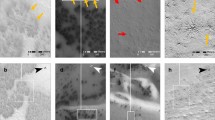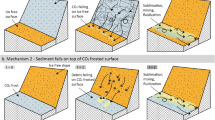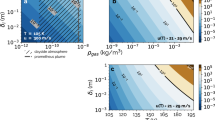Abstract
Sputnik Planitia is a nitrogen-ice-filled basin on Pluto1. Its polygonal surface patterns2 have been previously explained as a result of solid-state convection with either an imposed heat flow3 or a temperature difference within the 10-km-thick ice layer4. Neither explanation is satisfactory, because they do not exhibit surface topography with the observed pattern: flat polygons delimited by narrow troughs5. Internal heating produces the observed patterns6, but the heating source in such a setup remains enigmatic. Here we report the results of modelling the effects of sublimation at the surface. We find that sublimation-driven convection readily produces the observed polygonal structures if we assume a smaller heat flux (~0.3 mW m−2) at the base of the ice layer than the commonly accepted value of 2–3 mW m−2 (ref. 7). Sustaining this regime with the latter value is also possible, but would require a stronger viscosity contrast (~3,000) than the nominal value (~100) considered in this study.
This is a preview of subscription content, access via your institution
Access options
Access Nature and 54 other Nature Portfolio journals
Get Nature+, our best-value online-access subscription
$29.99 / 30 days
cancel any time
Subscribe to this journal
Receive 51 print issues and online access
$199.00 per year
only $3.90 per issue
Buy this article
- Purchase on Springer Link
- Instant access to full article PDF
Prices may be subject to local taxes which are calculated during checkout



Similar content being viewed by others
Data availability
All results necessary to produce the figures are available in the Zenodo repository https://doi.org/10.5281/zenodo.5511744.
Code availability
The convection code StagYY is the property of Paul J. Tackley and Eidgenössische Technische Hochschule Zürich. Researchers interested in using StagYY should contact Paul J. Tackley (paul.tackley@erdw.ethz.ch). Scripts for the treatment of results and drawing of figures have been written in Python (https://www.python.org/) using the StagPy package (https://github.com/StagPython/StagPy) and are available in the Zenodo repository, along with the data.
References
Moore, J. M. et al. The geology of Pluto and Charon through the eyes of New Horizons. Science 351, 1284–1293 (2016).
White, O. L. et al. Geological mapping of Sputnik Planitia on Pluto. Icarus 287, 261–286 (2017).
Trowbridge, A. J., Melosh, H. J., Steckloff, J. K. & Freed, A. M. Vigorous convection as the explanation for Pluto’s polygonal terrain. Nature 534, 79–81 (2016).
McKinnon, W. B. et al. Convection in a volatile nitrogen-ice-rich layer drives Pluto’s geological vigour. Nature 534, 82–85 (2016).
Schenk, P. et al. High-resolution topography of Pluto and Charon: getting down to details. In Proc. 49th Lunar and Planetary Science Conference (2018).
Vilella, K. & Deschamps, F. Thermal convection as a possible mechanism for the origin of polygonal structures on Pluto’s surface. J. Geophys. Res. 122, 1056–1076 (2017).
Hammond, N. P., Barr, A. C. & Parmentier, E. M. Recent tectonic activity on Pluto driven by phase changes in the ice shell. Geophys. Res. Lett. 43, 6775–6782 (2016).
Mangold, N. Ice sublimation as a geomorphic process: a planetary perspective. Geomorphology 126, 1–17 (2011).
Lliboutry, L. The origin of penitents. J. Glaciol. 2, 331–338 (1954).
Claudin, P., Jarry, H., Vignoles, G., Plapp, M. & Andreotti, B. Physical processes causing the formation of penitentes. Phys. Rev. E 92, 033015 (2015).
Moore, J. M. et al. Sublimation as a landform-shaping process on Pluto. Icarus 287, 320–333 (2016).
Forget, F. et al. A post-new horizons global climate model of Pluto including the N2, CH4 and CO cycles. Icarus 287, 54–71 (2017).
Bertrand, T. et al. The nitrogen cycles on Pluto over seasonal and astronomical timescales. Icarus 309, 277–296 (2018).
Buhler, P. B. & Ingersoll, A. P. Sublimation pit distribution indicates convection cell surface velocities of ~10 cm per year in Sputnik Planitia, Pluto. Icarus 300, 327–340 (2018).
Doumenc, F., Boeck, T., Guerrier, B. & Rossi, M. Transient Rayleigh–Bénard–Marangoni convection due to evaporation: a linear non-normal stability analysis. J. Fluid Mech. 648, 521–539 (2010).
Tackley, P. J. Modelling compressible mantle convection with large viscosity contrasts in a three-dimensional spherical shell using the yin-yang grid. Phys. Earth Planet. Inter. 171, 7–18 (2008).
Davaille, A. & Jaupart, C. Transient high-Rayleigh-number thermal convection with large viscosity variations. J. Fluid Mech. 253, 141–166 (1993).
Solomatov, V. S. Scaling of temperature- and stress-dependent viscosity convection. Phys. Fluids 7, 266–274 (1995).
Nimmo, F. et al. Reorientation of Sputnik Planitia implies a subsurface ocean on Pluto. Nature 540, 94–96 (2016).
Keane, J. T., Matsuyama, I., Kamata, S. & Steckloff, J. K. Reorientation and faulting of Pluto due to volatile loading within Sputnik Planitia. Nature 540, 90–93 (2016).
Eluszkiewicz, J. & Stevenson, D. J. Rheology of solid methane and nitrogen: applications to Triton. Geophys. Res. Lett. 17, 1753–1756 (1990).
Yamashita, Y., Kato, M. & Arakawa, M. Experimental study on the rheological properties of polycrystalline solid nitrogen and methane: implications for tectonic processes on Triton. Icarus 207, 972–977 (2010).
Bertrand, T. et al. Pluto’s beating heart regulates the atmospheric circulation: results from high-resolution and multiyear numerical climate simulations. J. Geophys. Res. Planets 125, e2019JE006120 (2020).
Scipioni, F. et al. Pluto’s Sputnik Planitia: composition of geological units from infrared spectroscopy. Icarus 359, 114303 (2021).
Earle, A. M. et al. Long-term surface temperature modeling of Pluto. Icarus 287, 37–46 (2017).
Gladstone, G. R. et al. The atmosphere of Pluto as observed by New Horizons. Science 351, aad8866 (2016).
Merlin, F., Lellouch, E., Quirico, E. & Schmitt, B. Triton’s surface ices: distribution, temperature and mixing state from VLT/SINFONI observations. Icarus 314, 274–293 (2018).
Sori, M. M., Bapst, J., Bramson, A. M., Byrne, S. & Landis, M. E. A Wunda-full world? carbon dioxide ice deposits on Umbriel and other Uranian moons. Icarus 290, 1–13 (2017).
Hofgartner, J. D., Buratti, B. J., Hayne, P. O. & Young, L. A. Ongoing resurfacing of KBO Eris by volatile transport in local, collisional, sublimation atmosphere regime. Icarus 334, 52–61 (2019).
Ortiz, J. et al. Albedo and atmospheric constraints of dwarf planet Makemake from a stellar occultation. Nature 491, 566–569 (2012).
Scott, T. Solid and liquid nitrogen. Phys. Rep. 27, 89–157 (1976).
Umurhan, O. et al. Modeling glacial flow on and onto Pluto’s Sputnik Planitia. Icarus 287, 301–319 (2017).
Trouette, B., Chénier, E., Delcarte, C. & Guerrier, B. Numerical study of convection induced by evaporation in cylindrical geometry. Eur. Phys. J. Spec. Top. 192, 83–93 (2011).
Crank, J. Free and Moving Boundary Problems (Oxford Univ. Press, 1984).
Hansen, C. J. & Paige, D. A. Seasonal nitrogen cycles on Pluto. Icarus 120, 247–265 (1996).
Ricard, Y., Labrosse, S. & Dubuffet, F. Lifting the cover of the cauldron: convection in hot planets. Geochem. Geophys. Geosyst. 15, 4617–4630 (2014).
Labrosse, S. Hotspots, mantle plumes and core heat loss. Earth Planet. Sci. Lett. 199, 147–156 (2002).
Choblet, G. & Sotin, C. 3D thermal convection with variable viscosity: can transient cooling be described by a steady state scaling law? Phys. Earth Plan. Inter. 119, 321–336 (2000).
McKinnon, W. B. et al. Origin of the Pluto–Charon system: constraints from the New Horizons flyby. Icarus 287, 2–11 (2017).
Néri, A., Guyot, F., Reynard, B. & Sotin, C. A carbonaceous chondrite and cometary origin for icy moons of Jupiter and Saturn. Earth Planet. Sci. Lett. 530, 115920 (2020).
McKinnon, W. et al. Pluto’s heat flow: a mystery wrapped in an ocean inside an ice shell. In Proc. Lunar and Planetary Science Conference 2715 (2018).
Davidsson, B. et al. The primordial nucleus of comet 67P/Churyumov-Gerasimenko. Astron. Astrophys. 592, A63 (2016).
Bardyn, A. et al. Carbon-rich dust in comet 67P/Churyumov-Gerasimenko measured by COSIMA/Rosetta. Mon. Not. R. Astron. Soc. 469, S712–S722 (2017).
Robuchon, G. & Nimmo, F. Thermal evolution of Pluto and implications for surface tectonics and a subsurface ocean. Icarus 216, 426–439 (2011).
Kamata, S. et al. Pluto’s ocean is capped and insulated by gas hydrates. Nat. Geosci. 12, 407–410 (2019).
Acknowledgements
We are grateful to P. Tackley for providing his mantle convection code StagYY, which we used for our calculations. We gratefully acknowledge support from the Pôle Scientifique de Modélisation Numérique of the ENS de Lyon for the computing resources. G.C. acknowledges the support from the Agence Nationale de la Recherche (France) under grant number ANR-20-CE49-0010.
Author information
Authors and Affiliations
Contributions
All authors developed the theory and designed the study together. A.M. modified the StagYY code; A.M. and S.L. ran the calculations and developed the analysis Python scripts. All authors contributed to the paper.
Corresponding author
Ethics declarations
Competing interests
The authors declare no competing interests.
Additional information
Publisher’s note Springer Nature remains neutral with regard to jurisdictional claims in published maps and institutional affiliations.
Extended data figures and tables
Extended Data Fig. 1 Topography slope.
Slope of topography for cases # 14 (left) and 15 (right), with the mean value written in the upper left corner.
Extended Data Fig. 2 Time evolution of output diagnostics for case # 14.
Evolution with time of the surface heat flux (a), the mean temperature (b), the RMS velocity (c), the effective Rayleigh number (d) and viscosity contrast (e) in the case of Fig. 2b, e of the main text. The first three quantities have been rendered dimensional using the nominal values of the parameters, see Table 1 of the main text.
Extended Data Fig. 3 Effective temperature as function of effective Rayleigh number for case # 14.
Evolution of the dimensionless temperature as function of the internal heating Rayleigh number, using secular cooling as effective internal heating source (see methods), for case # 14. The dashed line shows a guide to the eye for the expected scaling law in steadily cooling situation. The circled numbers correspond to snapshots, some being presented on Extended Data Fig. 4, the red ones being in the polygonal regime, which is first established at snapshot 18.
Extended Data Fig. 4 Pattern maturation for case # 14.
Four snapshots (# 2, 10, 18 and 30) of the surface topography (left) and mid-depth temperature anomaly (right) for case # 14, each associated with a circled number on Extended Data Fig. 3.
Extended Data Fig. 5 Temperature profiles during decaying convection.
Evolution of the horizontal minimum (blue), mean (red) and maximum (green) temperature profiles following the application of a zero heat flux at the upper surface of an established convecting system, case #14.
Extended Data Fig. 6 Decaying time-scale of convection.
Time evolution of the temperature anomalies (a, b) and the RMS velocity (c) after the surface heat flow has been set to zero. (a) shows the vertical mean of Tmax(z) − Tmin(z). (b) shows the RMS of \(T-\bar{T}(z)\), with \(\bar{T}(z)\) the horizontal mean of temperature. The exponential fit has been performed on values for time ≥55 kyr.
Extended Data Fig. 7 Time evolution of output diagnostics for a time-varying boundary condition.
Time evolution of the same diagnostics as in Extended Data Fig. 2 for a time varying boundary condition at the surface. The insets in each panel shows a zoom on the last 5 periods of the oscillations.
Extended Data Fig. 8 Convection pattern for a time-varying boundary condition.
Surface topography and mid-depth temperature anomaly at the end of the time varying run presented on Extended Data Fig. 7.
Extended Data Fig. 9 Evolution of the layer with an imposed bottom heat flux qbot = 0.26 mW m−2.
Panel (a) shows the evolution of the surface and bottom heat fluxes, (b) the mean temperature, (c) the RMS velocity, (d) the effective Rayleigh number, (e) the effective viscosity contrast and the bottom ones, snapshots of the topography at times written on their respective upper left corners.
Extended Data Fig. 10 Evolution of the layer with an imposed bottom heat flux qbot = 1.3 mW m−2.
Panel (a) shows the evolution of the surface and bottom heat fluxes, (b) the mean temperature, (c) the RMS velocity, (d) the effective Rayleigh number, (e) the effective viscosity contrast and the bottom ones, snapshots of the topography at times written on their respective upper left corners.
Extended Data Fig. 11 Evolution of the layer for Ra∞ = 109 and \({{\boldsymbol{R}}}_{{\boldsymbol{\eta }}}^{\infty }={{\bf{10}}}^{{\bf{4}}}\) with a zero imposed bottom heat flux.
Panel (a) shows the evolution of the surface and bottom heat fluxes, (b) the mean temperature, (c) the RMS velocity, (d) the effective Rayleigh number, (e) the effective viscosity contrast and the bottom ones, snapshots of the topography at times written on their respective upper left corners.
Extended Data Fig. 12 Evolution of the layer for Ra∞ = 109 and \({{\boldsymbol{R}}}_{{\boldsymbol{\eta }}}^{\infty }={{\bf{10}}}^{{\bf{4}}}\) with an imposed bottom heat flux qbot = 1.3 mW m−2.
Panel (a) shows the evolution of the surface and bottom heat fluxes, (b) the mean temperature, (c) the RMS velocity, (d) the effective Rayleigh number, (e) the effective viscosity contrast and the bottom ones, snapshots of the topography at times written on their respective upper left corners.
Supplementary information
41586_2021_4095_MOESM1_ESM.pdf
Supplementary information This file presents some diagnostics for the last snapshot of each studied case, as listed in Extended Data Table 1. For each case, the second column shows the surface topography, the temperature anomaly at mid-depth and the vertical profile of the r.m.s. of the horizontal velocity, all figures being dimensionless.
Supplementary Video 1
Supplementary video showing the evolution with time of the topography (left) and mid-depth temperature anomaly in case 14.1.
Rights and permissions
About this article
Cite this article
Morison, A., Labrosse, S. & Choblet, G. Sublimation-driven convection in Sputnik Planitia on Pluto. Nature 600, 419–423 (2021). https://doi.org/10.1038/s41586-021-04095-w
Received:
Accepted:
Published:
Issue Date:
DOI: https://doi.org/10.1038/s41586-021-04095-w
This article is cited by
-
Polygonal patterns of Faraday water waves analogous to collective excitations in Bose–Einstein condensates
Nature Physics (2023)
-
Buried palaeo-polygonal terrain detected underneath Utopia Planitia on Mars by the Zhurong radar
Nature Astronomy (2023)
-
Eolian erosion of polygons in the Atacama Desert as a proxy for hyper-arid environments on Earth and beyond
Scientific Reports (2022)
Comments
By submitting a comment you agree to abide by our Terms and Community Guidelines. If you find something abusive or that does not comply with our terms or guidelines please flag it as inappropriate.



